Ros Wilson, a Doctor from Australia, came for a three month stint to do a medical screening for all our rural students and teachers as well as train school nurses and manage the care of a few students with chronic conditions. We’ve never had a health care provider with us for such an extended period of time and were very pleased with the results of the mission.
This is Ros’s report:
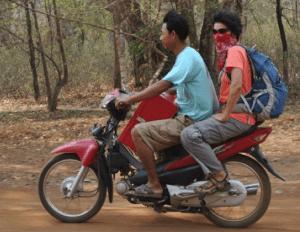
Ros Wilson on the way to Koh Ker School
Three months in Cambodia. It seems like a long time when you’re in the midst of planning the trip, trying to decide how large a bottle of sunscreen to take and how many pairs of shorts to pack. And some days, once you’re there, it can feel like an eternity – will I ever have clean feet again, just how big a risk is it to brush my teeth with tap water once in a while? And yet here I am, back in Australia, blinking in the sunlight and wondering where all that time went…I stayed at Seven Candles over Christmas last year and learned about the PLF’s work from Ponheary. Being fortunate enough to have a flexible schedule, I returned for three months this year, from February to May. I have some medical training so I was keen to get involved with some of the health-related aspects of the PLF’s activities.
In a short article like this it’s not possible to recount all of my adventures, so I’ll stick to my memorable moments.
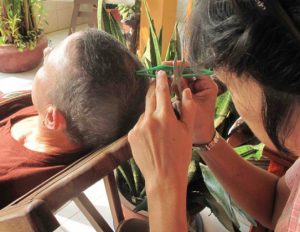
Putting sutures into Lori’s scalp – on the day I arrived, on the balcony of Barbara’s room at Seven Candles (because there was good light there) and a LONG time after my last suturing experience. Lori was an excellent patient, Barbara was a terrific assistant and I used a generous amount of local anaesthetic.
Working alongside the US “medical mission” (CHHIRP) during my first week, learning the basics of running a large-scale screening clinic (they screened about 1500 children). It was a real bonus and very generous of them to leave behind all the medical supplies they had brought with them. Not quite so much fun organising said supplies into some semblance of order and compiling a spreadsheet listing each medication, its uses, batch number, expiry date and quantity…but hopefully a useful exercise for anyone coming after me who needs to know what is in those three large grey trunks with the big red crosses on them.

Medical Screening at Koh Ker School
Spending four days in Koh Ker doing health screening at the primary school and the dormitory in Srayang, ably assisted by Ponheary, Lori, Dr Kim and the school staff. We managed to see everyone in two days (an outstanding effort), leaving us some free time to go touring around some of the lesser-known temples in the area. I got a huge kick out of riding on the back of a motorbike from the Srayang dormitory to our guesthouse on our first night, painting a picture in my head of our surroundings based on the different smells in the air as we rode along in the dark.
Medical Screening at Knar School
Health screening at Knar primary school during my last full week in Siem Reap, when we saw 400+ children…with the help of almost every member of the PLF team, at one point or another. It took about a week to finish this clinic, with a couple of false starts, thanks to bad weather and headaches. Headache is a common complaint in Cambodia and it’s almost always related to dehydration, because no-one (including tourists and resident foreigners) drinks enough water for the climate.

Every one of the first 12 kids we saw at Knar school had a headache, so rather than repeating the same information about the importance of drinking water several hundred times we decided to look for another way to address the headache topic. A couple of days later we returned to the school with a handout in Khmer and gave a short lesson to each class, then restarted the clinic. Being able to refer to the lesson and handout meant we could engage the kids in more of a conversation, asking them what they remembered from the talk and encouraging them to think more about why they had a headache and what they could do about it. Hopefully this is a little more effective than simply telling them to drink more water…it will be interesting to see how many of them have a headache next time the health screening is run.
The need to explain things that many of us take for granted – like an impromptu lesson about menstruation for the girls at Srayang dormitory; or that “hunger pangs” are most likely what kids at Knar were experiencing when they complained of stomach pain and nausea (and hadn’t eaten any breakfast or lunch); or why someone with heartburn might feel better if they eat regularly and avoid spicy food.
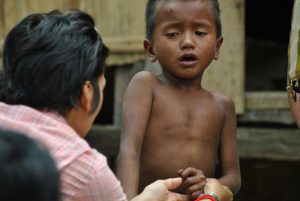
Putting a home-made bamboo splint on the arm of a young boy from a hill tribe village in Rattanakiri province. Three days earlier he had fallen from his house (they’re on stilts, a couple of metres above ground) and had been crying since. There was no possibility of an X-ray but his wrist looked swollen and sore enough to think it might be broken.
House calls in Knar village, following up on some kids who had been absent for a few days, or had been treated for various illnesses, often a chest infection, during the health screening. It was so great to see how much better and happier kids were after a couple of days of antibiotics.
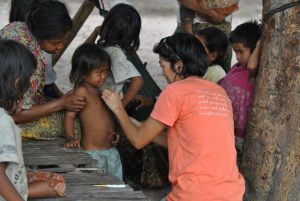
House calls at Knar village
One bright and caring big sister had seen us treat another student with antibiotic eyedrops for conjunctivitis and asked if we would go home with her because her little brother had the same problem. He was only about 18 months old and his eye was very red and sore looking, so he got some eyedrops, too. His parents looked pretty bemused when I suggested they wipe his eye with a clean, wet cloth each morning…no clean cloths, no clean water!
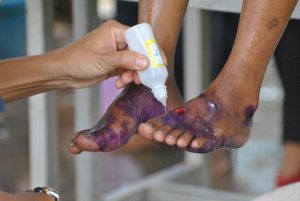
Gentian Violet
Being able to help two brave little girls at Knar school, one with nasty infected sores on both feet and the other with a longstanding itchy rash (scabies?) all over both arms and legs. We treated them consistently for the entire three month period and it was hugely gratifying to see them slowly get better. It was especially nice to see how they came out of their shells and their personalities emerged as time passed and their health began to improve.
Seeing a perforated eardrum from a middle ear infection heal by itself, over a couple of weeks – just like the textbooks say!
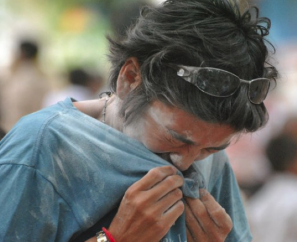 Khmer New Year celebrations at Knah school, where no-one was safe from the snowstorm of talcum powder and we all came home a few shades paler.
Khmer New Year celebrations at Knah school, where no-one was safe from the snowstorm of talcum powder and we all came home a few shades paler.
There are many more things I could reminisce about and my experiences in Cambodia taught me far more than I had expected when I first arrived in February. It was truly a deeply moving experience, at once heartbreaking and inspiring. For those of you who have been to Siem Reap and seen firsthand the PLF’s work, I hope these words bring back some great memories for you and do justice to the amazing people working with the PLF; for those of you who haven’t yet been, or who are thinking about going for a visit or to volunteer, I would say don’t worry too much about the details – book your flights, book your room at Seven Candles and let the universe take care of the rest.
It’s the things in life we didn’t do that we regret.
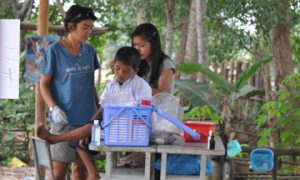
Ros at Knar School, training Chenda to be the School Nurse
Ros’ slideshow of her visit can be found here.

Recent Comments